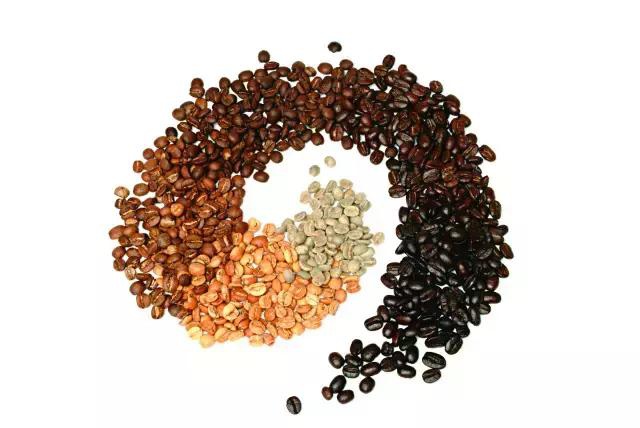Is the flavor of coffee beans inborn or baked? Which flavors of raw beans can the baker show?

Professional coffee knowledge exchange More coffee bean information Please pay attention to coffee workshop (Weixin Official Accounts cafe_style)
Sometimes, you'll see a lot of labels on the bean-cup scale that you haven't noticed before, such as almond pie, dried currants, green peaches, or cream. So, which of these unique flavors are inherent in coffee beans and which are presented through roasting?
Green coffee beans often have a "farm fragrance" like grass or hay, but if they are not properly preserved during storage and transportation, they can emit a musty, dusty, and even wet cat food smell, and sometimes you can smell a fermented smell similar to a long-aged red wine cork.
When you open the sack of raw beans on a good day, a sweet and ripe red fruit smell assaults your nose. As an aside, I am convinced that color can be perceived by smell. If you don't believe me, play some sensory Mini games, blindfold yourself, open a big bag of lollipops, and I bet you can tell the colors of most lollipops.
The bad odors mentioned above about coffee beans such as mildew or dust are mostly produced during planting, storage, packaging and transportation. Most of these odors will still be present after roasting. These flavors are masked or altered only in the case of extremely deep roasting.
Other flavors and aromas of coffee beans are innate, and we assume that all coffee fruits are picked at full maturity, so the aroma of coffee beans will be determined by the type of planting, the altitude of growth, the soil conditions, and the ecological environment.
When a coffee roaster wants to create a brand new blend, each bean is considered an "ingredient" just like a chef selects a condiment on a counter. Roasters are familiar with the characteristics of each bean and know exactly how they will affect the flavor of the new blend. Sometimes, the most significant contribution of a single bean to a blended coffee is not taste or aroma, but the tactile sensations it brings, such as body and taste. In different coffee blends, the main role of each individual bean will be different.
Continuing with the chef cooking example, the choice of different cooking levels will also affect the flavor of the ingredients. Onions, for example, are spicy, slightly spicy, bitter, sweet, caramelized, sizzling, burnt, and burnt, depending on how long they are cooked and how hot they are. We call it the onion's "flavor wheel." Similarly, it is impossible to smell all the inherent flavors directly from raw coffee beans. Different flavors and aromas are reflected in different stages of coffee roasting, but they disappear with the deepening of roasting.
So what flavor can a baker present in a born bean? I'm used to dividing it into eight stages, and of course there are more states in the middle of each stage, and the flavor presented will have all the characteristics of both stages. But the most basic flavor is still shown in the above picture.
In the first half of the graph, the flavor is close to raw beans. Those beans that are not baked or baked for too short a time will take on the flavor of hay, wheat, straw or harvested straw. Next, we'll taste citric acid, which resembles lemon. As the baking time increases, a soft acidity will develop, similar to the taste of Australian green apples. After that, the sourness will become brighter and take on a red-wine-like acidity.
The second half of the graph is the coffee flavor that most people prefer. As coffee beans continue to roast deeper into the medium roast, sweetness will replace sourness as the dominant flavor. As the coffee beans turn brown, they develop a series of caramel flavors, followed by cocoa flavors, which is the threshold for optimal coffee body. As the roasting progresses, the bitterness masks the sweetness and becomes more pronounced, resembling dark chocolate with 80% cocoa content. If coffee beans are roasted for too long, they lose all their positive flavor and we will experience the taste and smell of barbecue, charcoal, smoke, etc.
It is difficult for baristas to add apple or cream aromas to their coffee blends by roasting. What they can do is to increase the body, highlight the sweetness and other flavors (such as cream), and then incorporate a slight acidity and increase the aftertaste (such as green apple acidity).
When you create a brand new coffee blend, it is extremely important to pass on your ideas and feedback to the roaster in a timely manner. Only when you can articulate your idea and know exactly what flavor you want to present at different stages of coffee intake, aftertaste, etc., will your roaster find the best blend ratio for you.
END
Important Notice :
前街咖啡 FrontStreet Coffee has moved to new addredd:
FrontStreet Coffee Address: 315,Donghua East Road,GuangZhou
Tel:020 38364473
- Prev

Can't drink too much coffee? A new study finds that the safe intake of coffee is "frighteningly high"!
Professional coffee knowledge exchange more information on coffee beans Please follow the coffee workshop (official Wechat account cafe_style) the past issue that coffee is harmful to health may be a misunderstanding, because a new study finds that drinking even 25 cups of coffee a day does not cause heart problems. ▲ 's past issue that coffee is harmful to health may be a misunderstanding. According to the Daily Mail, a study by the British Heart
- Next

How to describe the coffee you drink, how to evaluate the coffee taste
Professional coffee knowledge exchange more coffee bean information please follow the coffee workshop (Wechat official account cafe_style) in general, we can describe how we feel about coffee in the following aspects: dry fragrance: does coffee smell fresh? Is the baking deep or shallow? Description: sweet, spicy, baked, nutty, malt, carbon, rotten, fresh, etc. Wet incense: add
Related
- How did the Salvadoran coffee industry develop in Central America?
- What exactly does the golden cup extraction of coffee mean?
- The Origin of Coffee flower
- [2023 Starbucks World Earth Day] there are more meaningful things besides free Starbucks coffee!
- What kind of coffee is there in Spain? 9 Flavors of Spanish Coffee
- Aromatic African coffee| Kenya's coffee culture and historical production area
- Liberica Coffee Bean knowledge: the characteristics of Liberian Coffee beans of the three original species of Coffee beans
- The origin and formula of Spanish latte introduces the taste characteristics of Bombon coffee in Valencia, Spain.
- How to adjust the solution of over-extracted coffee
- What is the tasting period of coffee beans? What is the period of coffee and beans? How should coffee wake up and raise beans?

